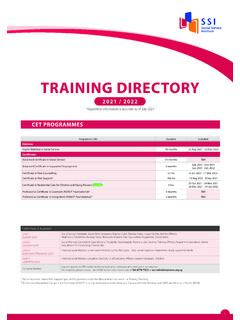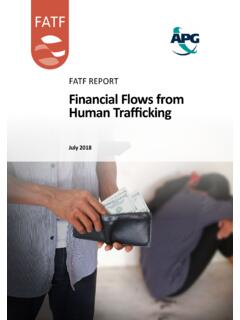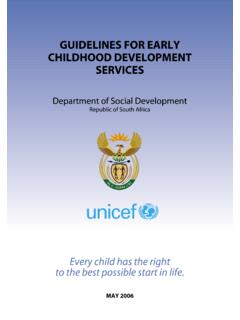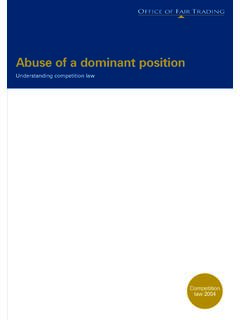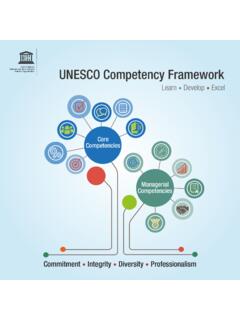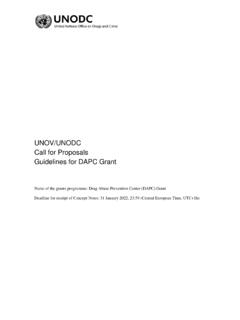Transcription of RISK OF TERRORIST ABUSE IN NON-PROFIT …
1 FATF REPORTRisk of TERRORIST ABUSE in NON-PROFIT OrganisationsJune 2014 FINANCIAL ACTION TASK FORCE The Financial Action Task Force (FATF) is an independent inter-governmental body that develops and promotes policies to protect the global financial system against money laundering, TERRORIST financing and the financing of proliferation of weapons of mass destruction. The FATF Recommendations are recognised as the global anti-money laundering (AML) and counter- TERRORIST financing (CFT) standard. For more information about the FATF, please visit the website: 2014 FATF/OECD. All rights reserved. No reproduction or translation of this publication may be made without prior written permission. Applications for such permission, for all or part of this publication, should be made to the FATF Secretariat, 2 rue Andr Pascal 75775 Paris Cedex 16, France (fax: +33 1 44 30 61 37 or e-mail: Photocredits coverphoto: Thinkstock RISK OF TERRORIST ABUSE IN NON-PROFIT ORGANISATIONS 2014 i CONTENTS GLOSSARY OF TERMS AND ACRONYMS.)
2 III EXECUTIVE SUMMARY .. 1 Understanding the Risk .. 2 Scope of the Project .. 3 Nature of the Threat .. 3 Mitigating the Risk .. 4 Categories of Risk .. 5 Detection and Disruption .. 6 Indicators .. 7 Next Steps .. 7 CHAPTER 1 INTRODUCTION .. 8 Background .. 8 Scope and objectives .. 9 The Terrorism Support Continuum .. 12 Terrorism Financing versus Money Laundering: Methods and risks .. 13 Data Collection and Sources .. 14 Collection of Case Studies .. 15 Collection of General Jurisdictional Data .. 16 NPO Sector Questionnaires and Workshops .. 16 Open-Source Research .. 17 CHAPTER 2 THE NPO SECTOR AND THE RISK OF TERRORIST ABUSE .. 18 The Global Environment .. 18 The NON-PROFIT 20 NPO Sector Operations and Vulnerabilities .. 23 The Current Nature of the TERRORIST Threat .. 26 TERRORIST ABUSE and the Risk to NPOs .. 28 Strategic Issues .. 32 Issue 1 A Tension Created by Equally Necessary Imperatives .. 32 Issue 2 National Responses to International 33 Conclusion .. 34 CHAPTER 3 METHODS AND RISK OF ABUSE .
3 36 Diversion of Funds .. 37 Diversion of Funds by Actors Internal to NPOs .. 38 Diversion of Funds by Actors External to NPOs .. 41 Affiliation with a TERRORIST Entity .. 42 ABUSE of Programming .. 44 Support for Recruitment .. 45 False Representation and Sham NPOs .. 47 RISK OF TERRORIST ABUSE IN NON-PROFIT ORGANISATIONS ii 2014 CHAPTER 4 METHODS OF DETECTION .. 49 NPO Regulatory Information .. 51 Open Source Information .. 52 FIU and Other Financial 53 National Security Intelligence .. 54 Law Enforcement Information .. 55 Foreign Cooperation and Information .. 55 Conclusion .. 57 CHAPTER 5 METHODS OF DISRUPTION .. 58 Sector Outreach, Education, and Self-regulation .. 59 Criminal Prosecution .. 59 Administrative Enforcement, Penalties, and Targeted Sanctions .. 61 Conclusion .. 64 CHAPTER 6 RISK INDICATORS AND TERRORIST ABUSE INDICATORS .. 65 The Nature of Indicators .. 65 Indicator Categories .. 68 Category 1: Financial Support to Known or Suspected TERRORIST Entities .. 68 Category 2: Material Support to Known or Suspected TERRORIST Entities.
4 69 Category 3: Financial, Material, or Logistical Support to Proscribed TERRORIST Entities .. 69 Category 4: Operations in Areas Where There are Active TERRORIST Threats .. 70 Category 5: General Operations and Governance .. 71 Category 6: Support for Recruitment .. 72 Category 7: Other Criminal Activities .. 72 CHAPTER 7 CONCLUSION .. 74 Strategic Considerations .. 75 Analytic Findings .. 76 Future Work .. 80 BIBLIOGRAPHY .. 81 APPENDIX A CASE STUDIES .. 87 RISK OF TERRORIST ABUSE IN NON-PROFIT ORGANISATIONS 2014 iii GLOSSARY OF TERMS AND ACRONYMS Note: For the purposes of consistency, all currencies in this report have been converted to US dollars (USD). Active recruitment: The recruitment of individuals by a TERRORIST movement through direct interaction with those individuals. (This type of recruitment is akin to talent-spotting. ) APG: Asia/Pacific Group on Money Laundering. Capability: The operational capacity of a TERRORIST group to carry out its objectives.
5 A threat is dependent on actors that possess both the capability and the intent to do harm, in this case towards the NPO sector. AML: Anti-money laundering CFT: Countering the financing of terrorism. CT: Counter-terrorism Detection: Any action, or series of actions, on the part of government or non-governmental actors that leads to the discovery of activity that could benefit TERRORIST entities. In the context of this report, this often involves the collection and analysis of different types of information. Directing official: An individual who holds a leadership position in an NPO and has the ability to direct aspects of the NPO s activities. This includes directors, officers, trustees, and religious leaders. Disruption: Any action taken by a government or non-governmental actor to interrupt activity that could benefit TERRORIST entities. DNFBP: Designated Non-financial Business or Profession.
6 Dual-use equipment: Equipment that has both peaceful and military applications, depending on intent. EFT: Electronic funds transfer. Expressive NPO: NON-PROFIT organisations predominantly involved in expressive activities, which include programmes focused on sports and recreation, arts and culture, interest representation, and advocacy. FATF: Financial Action Task Force. FIU: Financial intelligence unit. RISK OF TERRORIST ABUSE IN NON-PROFIT ORGANISATIONS iv 2014 Foreign fighters: Unpaid individuals who are noncitizens of conflict states who join insurgencies during civil conflicts. In the contemporary context, these individuals are often radicalised in their home country and take advantage of underground networks to facilitate their travel into a civil Foreign partners: A foreign entity assisting an NPO in carrying out activities or programmes abroad. Foreign partner agencies: National security, law enforcement, or regulatory agencies who exchange information with domestic agencies.
7 FSRB: FATF-style regional body. Humanitarian: In this report, humanitarian refers to the promotion of human welfare and is not limited to activities undertaken following emergency or disaster situations. Intent: The desire of an entity to do harm. (In the context of this report, the desire to ABUSE the NPO sector to support terrorism or TERRORIST entities.) Localised TERRORIST actor: Refers to i) citizens or legal residents of a country engage in TERRORIST activities within or from their home country, sometimes influenced by foreign actors. It should be noted that this influence could range from formal to inspirational. ii) individuals or small groups who have not been actively recruited by a TERRORIST organisation and who engage in TERRORIST activity on their own initiative in furtherance of a TERRORIST cause. Mandatory NPO reporting: Reporting that NPOs are required to submit to regulatory or oversight bodies.
8 This includes financial statements, programme information, information on activities, and other information used for regulatory or administrative enforcement purposes. Money laundering The processing of criminal proceeds to disguise their illegal origin. This: process enables criminals to enjoy their profits without jeopardizing their source. MSB: Money services business. National NPO regulator: National oversight body responsible for the regulation of national NPOs and the enforcement of standards across the national NPO sector. National security information: Intelligence or other sensitive information regarding threats to the security of a state or its citizens. National security intelligence can be derived from open, semi-open, or clandestine sources. NPO: NON-PROFIT organisation . 1 This definition draws on: Hegghammer, Thomas (2013), p. 1; Malet, David (2013), p. 9 RISK OF TERRORIST ABUSE IN NON-PROFIT ORGANISATIONS 2014 v NPO representative: In this report, NPO representative refers to an employee, volunteer, or another individual acting in an official capacity representing an NPO.
9 NRC: Norwegian Refugee Council. OCHA: United Nations Office of the Coordinator of Humanitarian Affairs. Passive recruitment: The recruitment of individuals by TERRORIST organisations through indirect means, often through different types of media, with the intention of instigating activities on the behalf of the TERRORIST organisation by those individuals. Proscribed TERRORIST Entities (also commonly termed listed entities): Individuals or organisations on national or international lists of actors known to be engaged in TERRORIST activities. Recruitment: The processes, both active and passive, through which TERRORIST entities seek to enlist operational personnel. Risk Indicator: In this report, risk indicator is an aspect of an NPO s activities that suggests ABUSE or risk of ABUSE that may be terrorism-related, but also has possible alternative explanations. Resources: Includes financial and non-financial NPO assets, including donations, property, gifts-in-kind, personnel, and documentation.
10 Risk: A function of three factors: threat, vulnerability and consequence. Service NPO: NON-PROFIT organisations predominantly involved in service activities, which include the programmes focused on housing, social services, education, and health Strategic shock: In the context of this report, a strategic shock is an event that causes a spike in demand for NPO funds or services. Major natural disasters, such as the 2004 Indian Ocean tsunami, are an example of a strategic shock. Front organisation : A legal entity created and controlled by a second organisation with the intent of masking illegal operations. Supporter: An individual not actively engaged in TERRORIST acts, but actively engaged in supporting TERRORIST entities. STR: Suspicious Transaction Report(ing). This includes suspicious activity reports and other forms of reporting from financial organisations relating to suspicious activities of clients.










